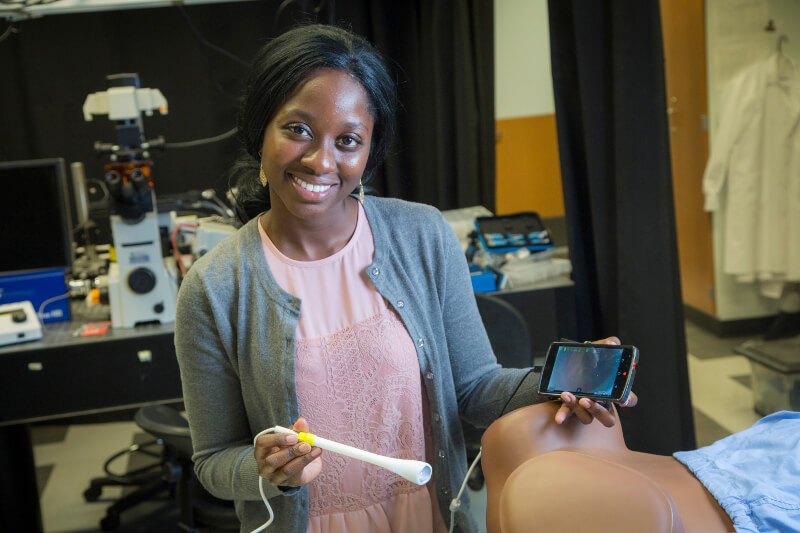
NCBiotech Funding Supports Portable Cervical Cancer Device Development
 |
| Duke graduate student Mercy Asiedu demonstrates the ease of use of the "pocket colposcope" she's helping to develop with the support of an NCBiotech grant. -- Duke University photos |
A grant from the North Carolina Biotechnology Center is helping Duke University researchers develop a cervical cancer screening tool that women everywhere might be able to use on themselves.
The $75,000 Technology Enhancement Grant (TEG) is supporting the commercialization of a “pocket colposcope” being developed by Nimmi Ramanujam, Ph.D., the Robert W. Carr, Jr., Professor of Biomedical Engineering at Duke.
It’s a handheld wand that can connect to many devices, including laptops or cell phones, aimed at replacing uncomfortable speculums and high-cost colposcopes for cervical cancer screening.
The Duke grant was one of five TEGs totaling $375,000 that NCBiotech awarded to four universities in the quarter ended June 30, 2017. These grants go to university technology transfer offices to support research and other commercially important activities that will make a technology licensable.
 |
| Duke Biomedical Engineering Prof. Nimmi Ramanujam, Ph.D. |
If Ramanujam’s invention can become widely adopted, women might use the device to self-screen, transforming screening and cure rates in low-income countries and regions of the United States, where cervical cancer is most prevalent.
Mercy Asiedu, a graduate student working on the project in Ramanujam’s lab, is also working to automate the screening process. By using image processing and machine learning to teach computers how to spot signs of precancerous and cancerous cells, Asiedu hopes to remove the need for a trained physician at any point in the screening process and shift the task to midwives, community health workers and even the women themselves.
Cervical cancer is the fourth most common cancer in women, with more than 500,000 new cases occurring annually worldwide. In the United States, physicians diagnose more than 10,000 cases each year. While more than 4,000 American women die of the disease each year, the mortality rate has dropped more than 50 percent in the past four decades, largely due to the advent of well-organized screening and diagnostic programs.
“The mortality rate of cervical cancer should absolutely be zero percent because we have all the tools to see and treat it,” said Ramanujam. “But it isn’t. That is in part because women do not receive screening or do not follow up on a positive screening to have colposcopy performed at a referral clinic. We need to bring colposcopy to women so that we can reduce this complicated string of actions into a single touch point.”
Ramanujam will be featured in a panel discussion at the 2017 Triangle Global Health Conference Friday, September 28 on the North Carolina State University campus. The 1:30 p.m. panel topic is, "Can we translate the multilateral strategies for cervical cancer prevention to address other global health disparities?”
